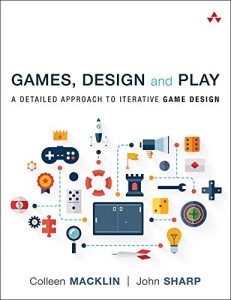Games, Design and Play completely demystifies the art of videogame design, by taking a play-focused and process-oriented approach that walks you through every step, and provides a complete toolkit for creating compelling game experiences.
Colleen Macklin and John Sharp draw on their pioneering experience teaching game design at Parsons (The New School for Design). Starting from the simple premise that game designs must emphasize play, they show how a game's structure can create a wide array of successful play experiences.
In Part I, Macklin and Sharp introduce the key concepts, terminology and principles of game design. They draw examples from many different forms of games, emphasizing independent and less-known games, videogames, board games, card games, sports, and even schoolyard games. Their examples are chosen to be especially relevant to readers who won't immediately have access to multi-million-dollar resources.
Step by step, they lay a strong foundation for exploring the broader expressive potential of games, and helping you learn to think like a game designer. Each chapter is accompanied by play and design exercises that help you put its key concepts into action.
You'll learn to wield each component of your "play machine": players, goals, rules, objects, actions, playspaces, and more. You'll also gain professional-level insights into multiple play styles and tastes, including competitive, cooperative, chance-based, whimsical, role-based simulation, performative, and expressive play.
In Part II, Macklin and Sharp turn to the practice of videogame design, introducing a powerful four-step iterative process: conceptualize, prototype, playtest, evaluate. For each step, Macklin and Sharp illustrate successive loops through this iterative cycle, from idea to finished game. You'll construct the game you've designed using the open source tool "Processing" - designed specifically to help non-programmers write code. You'll also learn how to work collaboratively as a game designer in your larger game development team.
This guide's unique approach bridges the gap between creative design processes and the technical side of game development, helping you craft great designs that can actually be transformed into great games!






